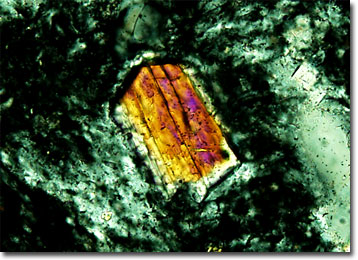Polarized Light Microscopy Digital Image Gallery
Volcanic Ash
Volcanoes are among the most awe-inspiring features of the Earth, and their activity has been attributed to various causes throughout history. The ancient Romans, for instance, believed that Vulcan, the god of fire, controlled volcanoes, while the Polynesians ascribe their action to the goddess Pele.

View a second image of Volcanic Ash
Found predominantly along plate tectonic boundaries, volcanoes erupt in a number of different ways and emit a variety of materials, including magma, gases, and pyroclastic rocks. These rocks are typically referred to by different names depending upon their size. The smallest pyroclastic rocks, which are no larger than sand grains, are called volcanic ash. Larger varieties are known as cinders or volcanic bombs, which may be as great as four feet in diameter.
Volcanic ash is quite different from more familiar types of ash, such as that generated by burning paper or wood. Instead of being soft or fluffy, the pyroclastic material is hard and insoluble in water. Particles of volcanic ash may also be much smaller than other ashes, often exhibiting diameters less than a thousandth of an inch in size. The mineralogical composition of volcanic ash generally depends upon the type of volcano it originates from and whether or not the material it ejects is primarily acidic or basic in nature.
